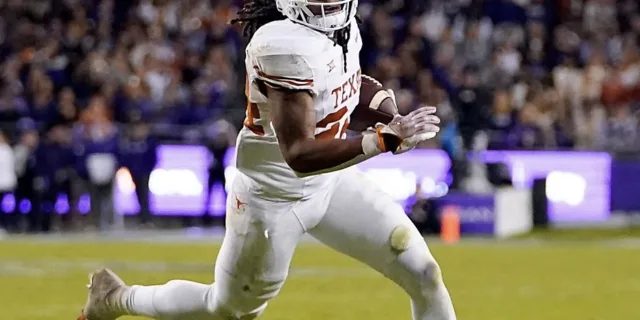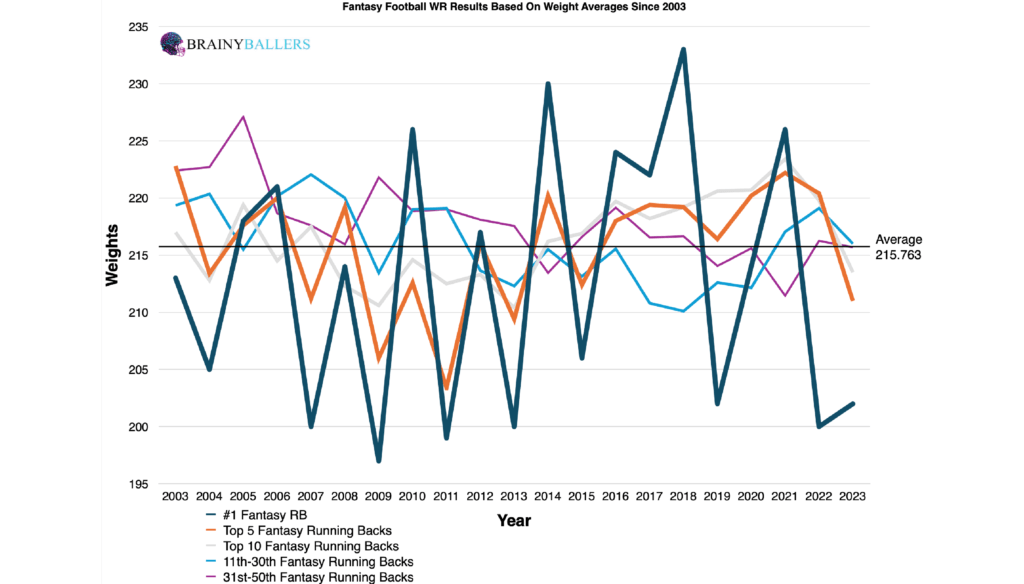
2025 Rookie Fantasy Football Dynasty Rankings
Having mapped out each position within our analytical model which predicts Fantasy Football points, we can now get a full picture of


In part 8 of our “Does It Matter?” series, we ventured into our first Running Back data to figure out if weight matters for NFL running backs and to uncover any correlations. Excitingly, we discovered a hard and soft range that could influence your favorite player’s success. Further, we look forward to the 2024 rookie RB class and matched all of those rookies up with our hard and soft ranges.
To ensure consistency, we relied exclusively on NFL Draft Combine numbers and analyzed the top 50 fantasy football finishers since 2003. All of our data is based on PPR scoring system. Our approach included:

Next, we segmented the top 10 and bottom 10 finishers by weight, comparing each pound. The bottom 10 is defined as fantasy football finishers 41-50 each season. When we did this, we discovered significant increases in production at certain specific weights. Notably, 213 and 214 pounds showed the most significant increase in performance, hinting at a potential hard range. Additionally, around 196 pounds a smaller yet notable increase suggested a possible soft zone.


To add depth to our findings, we constructed a differences chart. This compares each weight segment and the next 5 pounds among the top finishers while subtracting the corresponding data from the bottom 10. Essentially, the Top 10 finishers chart minus the Bottom 10 Finishers chart (seen above) for each 5 pounds beginning at the indicated weight. In this chart, you will see both unique and non-unique players that showed up in our data. The chart’s desired outcome is a negative number for unique differences and a positive number for non-unique differences. This desired outcome would show that when NFL Running Backs show up in the top 10, they are most likely to show up again.

This differences chart helped reveal two prominent weight ranges where RBs excelled. The soft range is where a smaller performance increase occurs but is still recognizable, and the hard range is where the highest performance increase occurs. Those ranges are indicated below, as taken from the differences chart:
Soft Range: 194-205 Pounds
Hard Range: 211-222 Pounds
Diving into the data further, we compared this hard weight range against the overall average of running backs in both the bottom 10 and top 10. In the bottom 10, there were 207 running backs with a weight measurement. 63 of these running backs fell within this hard range, account for 30.4%. This establishes a baseline to see if we found an average NFL running back weight, or if we found an average top performing NFL running back weight. A great revelation was made when examining the top 10 finishers from 2003 to 2023: 80 out of 210 finishers resided within this weight bracket, representing 38.1%. This accounts for a 7.7% increase over the bottom 10 baseline!
This fine-tuning ability helps us ensure we’ve identified the highest-producing range. After testing various numbers close to our initial findings, we found that adjusting the range to 214-221lbs resulted in a 11.1% higher occurrence in the top 10 than in the bottom 10. This range will be the subject of this article going forward.
As far as standard statical methods, we found a Pearson value of -0.041 between RB Weights and their corresponding fantasy football scores. This value shows strong correlation between a Wide Receivers’ hand size and their fantasy production. We are hoping for a minimum of 0.1, or an inverse correlation maximum of -0.1 while studying world-class athletes as we are. For reference to something that everyone acknowledges matters in prospect scouting, and to show the accompanying Pearson value, RB draft capital prevailed a -0.234 Pearson value.
Due these findings, weight will play a minimal factor in our Star-Predictor Score (SPS) model for Running Backs, which predicts busts and successes, and has had success most recently in predicting player performances such as Brian Thomas Jr. over Malik Nabers and Marvin Harrison Jr., all while having Justin Jefferson as the number 1 Receiver all time. Information on the SPS, and where to find it, can be found here.

We also analyzed trends over two decades to understand the evolving significance of these weight ranges. Between 2004-2013 and 2014-2023, and including the soft range, the breakdown is as follows:
| 2004-2013 | |||
| Top 10 | 11 through 40 | Bottom 10 | |
| All count | 100 | 300 | 100 |
| Between 214 and 221 | 33 | 86 | 19 |
| % (hard zone/all) | 33.0% | 28.7% | 19.0% |
| 2014-2023 | |||
| Top 10 | 11 through 40 | Bottom 10 | |
| All count | 100 | 300 | 100 |
| Between 214 and 221 | 29 | 62 | 22 |
| % (hard zone/all) | 29.0% | 20.7% | 22.0% |
These trends indicate a consistent drop in the bottom 10 RBs across both decades. Further, it appears as though this weight range was more significant in the earlier decade.
To have some extra fun, we found that the average weight for all athletes in our data was 217 pounds. Also, the median time was 216 pounds.
We now turned our attention towards finding weights that never happened in different fantasy football leaderboard thresholds. Here are the minimum shuttle times seen across different leaderboard thresholds since 2003:
Due to these findings, 187 pounds will be our critical value. This is for our StarPredictor Score (SPS) model, where we will be attempting to predict NFL successes or busts. Essentially, athletes must weigh at or over 187 pounds in order to not be considered a surefire bust.
Our analysis didn’t stop there as we wanted to look forward to the upcoming rookie class. We segmented out each rookie into the range they fell in including ones who fell out of both ranges.
The Soft Range is a lighter weight with less top producing historical backs, but still significant enough to not ignore. Here are the players in this category:
Running backs in the Hard Range are in the heaviest range and have the highest historical top level producers. Here’s a list of rookies in this weight range:
By no means are we saying players outside both ranges will never produce positively, although we do recommend taking this into account when evaluating talents. Especially if they are on the low or high side of both ranges. Here are the players who do not fit into the Soft or Hard Range:
Our in-depth analysis suggests that weighing between 214-221 pounds provides a slight performance boost historically to running backs. Whether in the Soft Range, Hard Range, or outside both ranges, by no means are we saying this list of players corresponding to the ranges is the only thing anyone should take into account. Rather, this should be used as a tool to supplement your research of players.
To go over it again: our study found two distinct weight ranges corresponding to running back success: a “soft” range spanning from 194 to 205 pounds and a “hard” range from 214 to 221 pounds, with the hard range showcasing a higher peak in performance.
What metric matters the most when scouting a rookie Running Back? What threshold should Running Backs achieve within that metric to be considered an elite prospect? How much should you value that stat above all other stats? Couldn't answer those questions? Rest easy, we have it handled for you. That's what this chart answers. Sort by importance and/or filter by position. Unlock by signing up with the links provided. $9.99/Year or $24.99 Lifetime access. Cancel anytime.
Our series has always sought to push the boundaries of sports analytics, and this latest installment reaffirms our commitment to uncovering the hidden dynamics that define the game. Every Saturday We will dive deep into the most intriguing questions, bust myths, and settle debates with thorough analysis similar to this. We thrive on curiosity and welcome your input — so please, leave comments or reach out to us with topics you’re eager to see dissected next. All of our research can be found on our Analytics Page. Up next on our agenda for Part 9 of “Does It Matter? is our next examination of Running Backs: Does Height matter? If so, what’s the ideal height for a RB? Mark your calendars; every Saturday we shed light on the topics that matter to you. All it takes is a short question and we will go to work for you!
Support these analytics and unlock our Ultimate Athlete Blueprints, where all of our research comes together in one table for all positions. $10 lifetime access.

BrainyBallers Buy-Hold-Sell Chart (All Players)
Make Money on BrainyBallers’ (Or anyone’s) content if it turns out to be incorrect!

Having mapped out each position within our analytical model which predicts Fantasy Football points, we can now get a full picture of

For our 57th installment of the “Does It Matter?” series, we looked into whether a quarterback’s rookie Yards Per Game (YPG) can

Jaxson Dart’s journey into the spotlight of the Big Apple began in the town of Kaysville, Utah. Born here, his early years